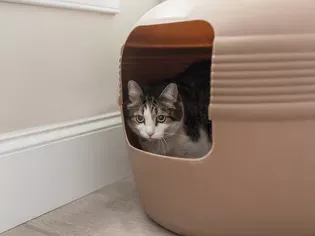Cat Can't Pee? Here's What to Do
Updated on 04/26/24

Cat Can't Pee? Here's What to Do
As a cat owner, witnessing your beloved feline struggling to urinate can be a distressing experience. Urinary issues in cats are common, but prompt attention is crucial to prevent serious complications. This comprehensive guide will provide you with the essential knowledge and actionable steps to take when your cat can't pee.
Understanding the Causes
Various factors can contribute to urinary problems in cats. Some of the most common causes include:
* Urinary Tract Infections (UTIs): Bacteria enter the urinary tract, causing inflammation and difficulty urinating. Symptoms include frequent attempts to urinate, straining, and bloody or cloudy urine.
* Feline Idiopathic Cystitis (FIC): A common condition in cats with an unknown cause. It involves inflammation of the bladder, leading to frequent urination, discomfort, and blood in the urine.
* Urethral Blockage: A life-threatening condition where crystals or debris obstructs the urethra, preventing urine from passing. Symptoms include straining to urinate, abdominal pain, and toxic shock.
* Uroliths (Bladder Stones): Hard mineral deposits that form in the bladder. They can block urine flow, causing pain, straining, and blood in the urine.
Recognizing the Signs
Spotting the signs of urinary problems is crucial for early intervention. Common symptoms to watch out for include:
* Frequent attempts to urinate without producing much urine
* Straining or crying during urination
* Blood or cloudiness in the urine
* Frequent licking of the genital area
* Lethargy or loss of appetite
* Vomiting or diarrhea
What to Do When Your Cat Can't Pee
If you suspect your cat is having trouble urinating, it's essential to take them to the veterinarian immediately. The veterinarian will perform a physical examination, collect a urine sample, and possibly conduct imaging tests to diagnose the underlying cause.
Treatment options will vary depending on the diagnosis and may include:
* Antibiotics: For urinary tract infections
* Pain medication: To relieve discomfort and inflammation
* Urethral catheterization: To manually remove the blockage
* Surgery: In severe cases of uroliths or urethral obstruction
Home Care and Prevention
While professional veterinary care is essential, there are steps you can take at home to support your cat's urinary health and prevent future problems:
* Encourage Water Intake: Provide plenty of fresh, clean water to promote hydration and flush out the urinary tract.
* Feed a Urinary Health Diet: Special diets formulated for urinary health can help prevent the formation of crystals and stones.
* Clean the Litter Box Regularly: A clean litter box reduces the risk of bacteria buildup and infections.
* Manage Stress: Stress can trigger urinary problems in cats. Provide a calm and comfortable environment to minimize stress levels.
* Monitor Your Cat's Weight: Obesity can increase the risk of urinary issues. Maintain a healthy weight for your cat.
Additional Tips
* Observe Your Cat's Urination Habits: Keep track of their frequency, duration, and any unusual behaviors to provide valuable information to the veterinarian.
* Use Calming Aids: Pheromone sprays or diffusers can help reduce stress and anxiety, which may contribute to urinary problems.
* Consider Urinary Supplements: Cranberry supplements or homeopathic remedies may provide additional support for urinary health. Consult with your veterinarian before using any supplements.
Conclusion
Urinary problems in cats can range from minor inconveniences to life-threatening emergencies. By understanding the causes, recognizing the signs, and taking prompt action, you can help your beloved feline overcome these challenges and maintain optimal urinary health. Remember, early intervention is key to successful treatment and prevention.
Explore More Pets

Cat Behavior Problems
How to Stop Aggression in Kittens

Long-Haired Cat Breeds
Siberian Cat: Breed Profile, Characteristics, & Care

Cat Behavior Problems
How to Stop Kittens From Scratching and Biting

Long-Haired Cat Breeds
Turkish Angora: Cat Breed Profile, Characteristics & Care

Basic Training
How to Socialize Your Kitten

Short-Haired Cat Breeds
Cute Pictures & Facts About Calico Cats & Kittens

Litter Box Training
Training Your Kitten to Use the Litter Box

Long-Haired Cat Breeds
10 Fun Facts About White Cats